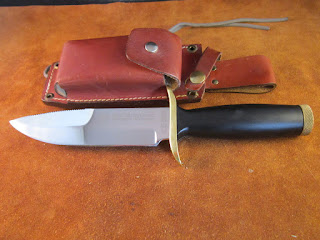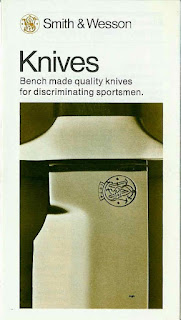70’s Hackman of Finland Survival Knife
Designed by Ken Warner and Pete Dickey; this rare knife was made during the late 1960s and early 1970s. It is not recorded how many were made by Hackman with a 1/4" blade made in Finland, it could be only 1,000. The designed was than cloned and produced by Garcia in Brazil with a 3/16" blade and the same Brazil sheath. The Original Hackman survival knife was intended for private sale to military personnel bound for Vietnam. The Randall Model 18 had made the hollow handle sawback popular with the troops, but Randall could not keep up with demand. Like the Randall this knife featured a watertight hollow handle and a massive 1/4" thick stainless-steel blade with sawback.
From Ken Warner's book "The Practical Book of Knives" circa 1975, Chapter 7-The Sharp Pry Bar:
"The Hackman Survival Knife has a 7" blade of spear point design with saw teeth on the back. These are genuine kerf-cutting saw teeth, not mere aluminum ripping serrations. It is possible, though very strenuous, to saw off a 2x4 with this knife. It was designed to be made by Hackman of Finland in stainless steel and the first batch were. The first 1,000s were awfully good knives. I have no experience with the later produced Garcia’s but they are much more lightly constructed, which still leaves them heavy. (The Hackman Survival knife was very heavy and intended to be. I don't believe a stronger blade of 1/4" stock was ever produced.)"
"I was responsible for the shape and the grind of the blade and the overall configuration. My collaborator, Pete Dickey, figured out the rest of it. In essence, it has a hollow stainless-steel handle, closed watertight by a large threaded pommel. The space inside is nearly the size of two 12-gauge shotshells, which means it will hold matches, pills, another little knife, hooks and line-a whole raft of stuff that could come in handy. Pete went ahead and had packed a miniature kit that went into the sheath's pocket and had a lot of that gear in it."
(As a sidelight on that knife, Bill Moran bought 100 of them, edged them himself and sold them, furnished with his handmade sheath, to those of his customers who needed a good heavy knife and could not wait the three years or so for one of Bill's own masterpieces. Four or five of them kicked back at him-trouble in the handle/blade joint-but that is all. I consider that good performance because almost all of these, by nature of the way they were sold, went to users, not collectors.)
"Anyways, I put all I could think of into that knife to make it do as many jobs possible for a fellow who suddenly must do it all with a knife. So did Pete. It is heavy and tough enough to chop wood or meat or bone. It is wide enough to dig with if you need a hole in a hurry. The saw edge is designed to get its users poles without making loud noises. Its steel will not rust and it is hard, so it holds an edge. If you had to hurt someone with it, it is equal to that job. It will slice very nicely and after you get used to it, handy for dressing out game. It has a couple of holes in the modest double guard, and by lashing through those to a pole seated in the hollow handle, a rather impressive spear results
Information provided from Fitzwillies.com and
Ken Warner's book "The Practical Book of Knives" circa 1975
More details; https://fitzwillies.com/








Comments
Post a Comment